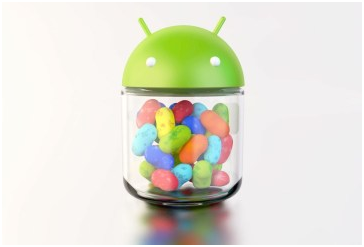First impressions of the new Android 4.1 Jelly Bean
Shortly after the announcement of version 4.1 “Jelly Bean” Android , at the opening of the Google I / O 2012, managed to get my hands on a Samsung Galaxy Nexus running the new system. And after a little snooping and analyze the news, I discovered that Google hit on several points, but there are still parts that need more work.

This is the mascot of the Android 4.1 “Jelly Bean”
What is right?
The Jelly Bean is fast, attractive and is like the Ice Cream Sandwich (Android 4.0) should have been when it was announced six months ago. The performance gain is due to what Google calls “Butter Project”, a framework designed to improve response, smooth animation and reduce the latency of the interface and application as a whole. I compared a Galaxy Nexus running with my own Jelly Bean Galaxy Nexus running Ice Cream Sandwich, and noticed the difference almost immediately. The delay when opening an application is practically zero, and the effect of scrolling the various home screens is incredibly smooth. The interface in general looks pretty much the same, but there are little animations here and there that give a more refined.
Animations
Each time you open an app, you see a short animation with a “zoom” on the corresponding icon. It is superfluous, but they are small details like this that make the Jelly Bean more pleasant to use. There are some other minor interface tweaks, such as icons larger and easier to play.
The notification area got a little change, but the most important here are the new notifications.Some of them can be extended using gestures with two fingers (the now famous “pinch”), allowing you to see more information at once.
The new reports show further information at a time
Not all applications support this feature, but it worked with all the Google applications preinstalled. Actually, while I wrote this subject received an alert saying the calendar that I would be late for an event. When I pulled the notification panel to see more details, I could read part of the event name, date, place and a brief description, without having to open any application.
Below there was a button that allowed me to delay the alert, I could do without even leaving the panel. It is a smart way to make notifications less intrusive, and I hope that all developers take advantage of this feature.
The camera
The camera application also gained some new tricks, including new animations that happen when you take a picture. When finished, you can slide your fingers on the screen to switch between camera and gallery and see the pictures he took.
Now it’s easier to switch between the camera and the gallery (above)
Now Google
Google did not skimp when it comes to efforts to search Google from a device with Jelly Bean.The new service “Google Now” can be accessed from anywhere in the system, simply slide your finger up from the Home icon in the navigation bar. His first page in Google Now is sparse as well, showing the weather and maybe a few places around that you want to visit (their position is obtained using the GPS).
Now Google uses your search history to know what you need
But the more searches you do on your smartphone, Google Now more will learn about you and your needs. To test this I did several searches related to baseball and a sports section appeared on my page on Google Now. If you do not like a section, you can disable it in settings.It’s a very visual way to obtain basic information and it worked well – but I feel that more can be done with this information, and I hope that Google continues to expand Google Now.
Search by Voice
The voice search is a much simpler interface and the results are more interesting. Ask a simple question like “What is the capital of Spain?” And you will see a card with your answer, as in a game of trivia.
If you are not satisfied with the answer, or want to know more, you can simply “throw out” the card with a gesture to see the traditional display of search results Google. I asked some questions and, after Google got used to my voice, get answers to almost everything we asked.
What is still wrong?
While many things in Jelly Bean seem to work well, found some defeitinhos. Among them was a strange effect “ghost” images in motion, especially when scrolling the screen, which was not present at the Ice Cream Sandwich. I imagine that is the result of several new APIs used for text and smoother graphics. But it is remarkable, especially when scrolling screens full of text, such as web pages.
Another problem is something that affects the Android for some time: fragmentation. With so few devices currently able to run Ice Cream Sandwich, and many more still waiting for an update, it seems unlikely that the majority of devices currently on the market (outside the Galaxy Nexus and Nexus S) to receive an update to the Jelly Bean.
It may be that the Jelly Bean solves many of the performance problems associated with the Android, but fragmentation will remain a problem. I strongly suspect that the developers decide to take advantage of all the new features of the system, especially if we consider that the vast majority of users still running Android 2.3 “Gingerbread”, or something even older.







